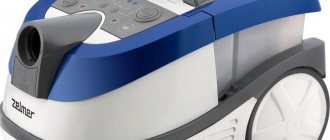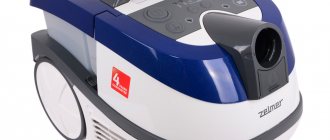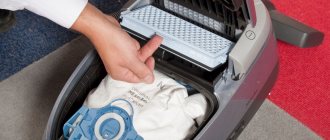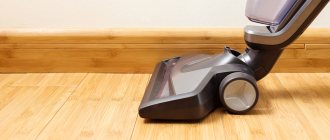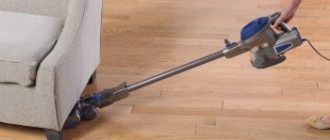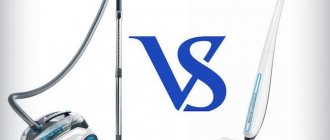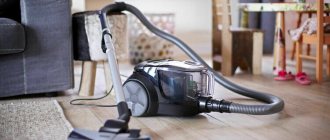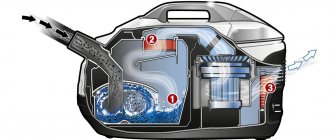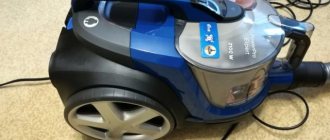Safety precautions for use
To operate the vacuum cleaner correctly, it is important to follow safety precautions:
Make sure that all air is completely removed from the hose before use. Do not allow air to enter the pump, otherwise the device will fail.- Turn off the pump before removing the vacuum cleaner brush from the pool. If this rule is not followed, air will enter the system.
- When operating the device in the pool, the water should be calm and without waves.
- It is necessary to warn children and household members that no one should be in the bowl while the vacuum cleaner is operating.
- Do not connect the power source to an ungrounded outlet.
- Do not turn on the device until it is completely immersed in water - using the vacuum cleaner on dry land will damage it.
- After finishing work, the device must remain in the pool for 15 minutes to allow the motors to cool completely.
- Do not leave the vacuum cleaner in water for a long time - after use, it must be dried and returned to storage.
Before using the vacuum cleaner, you should ensure that all specified safety precautions are followed.
Preparing for cleaning
Before cleaning the pool, the following preparations must be completed:
- remove all foreign objects from the water: children's toys, balls, inflatable rings;
- make sure that there is no one in the pool;
- use a brush to clean all adhered dirt from the side walls of the reservoir;
- leave the bowl alone so that all the debris remains at the bottom and does not float in the water;
- turn off the pump and flush the filtration system, since during operation a large load is placed on these elements; for effective cleaning they must be cleaned;
- After the debris and dirt have settled to the bottom, all preparatory steps have been completed, you can use the vacuum cleaner.
Principle of operation
Each type of vacuum cleaner has its own operating principle.
Manual
Handheld water vacuum cleaners are the simplest models. In addition to the vacuum cleaner itself, the kit includes all the required accessories:
- a net to collect debris in the water column;
- a brush used to clean the walls and bottom of the bowl;
- telescopic rod (holder).
Principle of operation:
- The nozzle is fixed on a metal holder.
- This rod is connected to the hole through which water is supplied to the pump - a hose is used for this.
- Large particles of debris are retained in the flask attached to the base of the nozzle.
- Small particles fall into the filter, where they settle.
Condition for operation of the device: the pump used must have a capacity of at least 3000 liters per hour. The device is suitable for cleaning the bottom and walls of the bowl. And when using a net, you can remove debris from the surface of the water.
The vacuum cleaner is suitable for pools up to 40 cubic meters. Can be used for framed and frameless bowls.
Semi-automatic
Semi-automatic models work on the same principle as manual ones. But the difference lies in the presence:
- valve, which is washed manually. It increases water pressure and speed of pool cleaning;
- built-in bag where garbage is collected (in some models).
Operating principle:
The soft rubber nozzle sticks to the bottom of the bowl.- The connected filtration system creates pressure.
- The vacuum cleaner moves slowly.
- The contaminants collected by the device are sent to a garbage bag or to a sand filter unit.
- The sediment is retained by the filter material.
The device is suitable for medium-sized pools with a perfectly flat bottom.
The advantage of a semi-automatic model is that it is more effective at cleaning compared to the manual version. The downside is that it is not suitable for bowls with an uneven bottom .
Auto
Automatic varieties are represented by robotic vacuum cleaners for cleaning the pool.
They are the most modern and improved. Management is carried out using built-in programs.
Principle of operation:
- the device quickly copes with plaque and debris in the pool;
- works autonomously;
- no need to connect to the mains;
- the user does not need to control the operation, just set the mode and start the cycle;
- the robot independently moves along the bottom and walls of the bowl, filtering water and removing blockages.
Advantages of a robot vacuum cleaner:
- Cleaning is fast and high-quality, regardless of the degree of contamination of the pool.
- Suitable for all bowl shapes.
- Suitable for uneven bottoms: with steps, bulges.
- Self-filters water.
- There is a disinfection function.
- Even hard-to-reach places are cleaned.
- The owner can control the robot using a remote control.
Review of robotic vacuum cleaners for pools and recommendations for choosing - in the video:
How to use?
Pool vacuum cleaners can be autonomous (robots) or manual. For proper operation and effective cleaning, you must follow the step-by-step instructions.
Clean with a stand-alone device
An autonomous vacuum cleaner just needs to be programmed correctly , and it will do all the work on its own. The user controls the device from the remote control.
The autonomous device does not require connection to a skimmer or filtration system; it moves freely along the bottom and walls of the bowl.
It is advisable to use robotic vacuum cleaners for cleaning large swimming pools that are difficult to clean manually. At the same time, even modern devices cannot clean blind spots in bowls of non-standard shape.
The device has the following configuration:
- vacuum cleaner and floating cable;
- transformer - power supply;
- cart.
Instructions for use:
- Before work, turn off the pump.
- Release the cable of the vacuum cleaner; it must be completely unwound.
- The power supply is located at a distance of at least 3 m from the bowl.
- Place the movable handle diagonally above the vacuum cleaner and fix it.
- Lower the device into the water.
- To release air from the vacuum cleaner, turn it in different directions and plunge it to the bottom.
- Stretch the cable over the surface.
- Connect the power supply to the outlet (it must be grounded).
- Turn on the device - the indicator will light up and the cleaning cycle will begin.
If the pool is heavily contaminated, several cleaning cycles are carried out.
Manual device
Using a handheld vacuum cleaner, you can clean the bowl through a sand filter or without using it.
Through a sand filter
To clean the walls and bottom using a sand filter, follow these instructions:
Place a suitable attachment on the handle of the vacuum cleaner.- Securely attach the hose to the nozzle of the device, select the optimal length of the handle.
- The nozzle is lowered to the bottom of the bowl.
- Fill the hose completely with water, immersing it in water gradually.
- The second part of the hose is connected to the filter or nozzle.
- Turn on the pumping device and collect debris.
- Move the brush along the bottom slowly, without making sudden jerks, otherwise you will have to repeat cleaning many times.
- After making sure that the bottom is clean, move on to the walls and corners, changing the nozzle if necessary.
- After cleaning, disconnect the hose on each side, pour out the water and dry all the parts.
After cleaning is completed, leave the filtration system running for 3 hours. Then be sure to rinse the sand filter, as it will be very clogged.
Without connection to the filter
If the pool is excessively dirty, then you should not clog the filtration system with this debris.
In this case, it is advisable to move the control valve to the drain position. This way, dirt from the water is removed directly into the sewer, bypassing the filter.
In this case, it is important to ensure that the water level does not reach the minimum mark; to do this, add fresh water in a timely manner.
Instructions for use:
- remove all foreign objects from the water, wipe the walls and bottom of the bowl with a brush;
- fill the hose with water so that no air bubbles enter the pump;
- make sure that the water is in a calm state;
- turn on the vacuum cleaner;
- work slowly with a brush, sweeping along the surface of the bottom and walls, trying to collect all the debris;
- To consolidate the result, the same procedure is repeated.
Pool vacuum cleaner models
When planning to buy a vacuum cleaner for a pool to clean the bottom, walls of the bowl, and the waterline of the pool, check out the popular modifications. In addition, when choosing the optimal device, take into account the dimensions of the pool so that the selected vacuum cleaner can do the necessary job efficiently. Well-known brands of underwater vacuum cleaners include Blaster, Zodiac, Dolphin and some others. Some of the most popular models are:
- Intex Auto Pool Cleaner 28001;
- Dolphin SUPREME M5;
- RV 4400 Vortex PRO 2WD from Zodiac;
- Bestway 58324;
- Bravo.
Handheld Pool Vacuum Cleaner
An underwater vacuum cleaner of this type is the simplest, and in terms of design it consists of a telescopic rod with a handle, a corrugated hose, a special brush, an electric cable and a motor. The peculiarity of this device is its direct connection to a reservoir skimmer or vacuum nozzle using a specially designed adapter. Suitable for any artificial reservoirs, be it a country pool or a large stationary analogue. This device is characterized by an affordable price and ease of operation. A good purchase would be:
- model name: BestWay 58427 BW;
- price: 5299 rub.;
- characteristics: dimensions – 515x150x165 mm, weight – 2.11 kg, telescopic handle length – up to 3 m;
- advantages: independence from the electrical network;
- Cons: Expensive for a manual model.
The price of the following product is indicated with a 22% discount. The hand-held vacuum cleaner described below has adapters for connecting to any filter systems and a vacuum attachment:
- model name: Bestway kit 58234/58237;
- price: 2800 rub.;
- characteristics: aluminum rod – 2.79 m, hose – 6 m, diameter – 32 mm, has a bottom brush, weight – 3 kg;
- pros: cheap, cleans bowl surfaces well;
- cons: none.
Auto
Such a device independently copes with the task. The operating principle of an automatic or robotic vacuum cleaner is based on computer technology, thanks to which you can set certain program parameters. This approach ensures that the equipment is completely turned off after cleaning is completed. In general, an automatic vacuum cleaner is an autonomous programmable mechanism whose functions include high-quality water filtration and cleaning the walls and bottom of the pool. Reliable and powerful automatic robot vacuum cleaner:
- Model name: Zodiac Vortex 1;
- price: RUB 37,900;
- characteristics: for a pool up to 5x10 m in size, pump capacity – 11 cubic m/h, cable length – 18 m, weight – 6 kg;
- pros: power, compactness, light weight;
- cons: no remote control, high cost.
- Heartburn - causes and treatment of the disease
- Signs of diabetes in women
- Names for girls: beautiful options and meanings
Vortex 4 4WD is a functional and modern device that can perfectly cope with any type of pollution. The device is based on VORTEX technology:
- model name: Zodiac Vortex 4 4WD;
- price: RUB 139,900;
- characteristics: for a pool up to 15x7 m in size, pump capacity – 16 cubic m/h, length – 21 m, weight – 9.5 kg;
- pluses: several operating modes, there is a remote control, a trolley;
- cons: very expensive.
Semi-automatic
The design of such devices provides for operation on hydraulic traction with the ability to adjust the speed of water flow. A distinctive feature of a semi-automatic vacuum cleaner is the presence of a special bag for collecting garbage and direct connection to the skimmer without additional tools. Another important feature that increases the efficiency of the device is the presence of a valve. This helps to automatically regulate the water flow and ensures high cleaning speed:
- model name: Zodiac T5 DUO;
- price: RUB 30,016;
- characteristics: for pools measuring 6x12 m, suction power – 8 cubic m/h, hose length – 12 m, movement speed – 6 m/min, weight with packaging – 9 kg;
- pros: DiaCyclone technology increases suction power by 40%;
- cons: cost.
If you are interested in purchasing a cheaper semi-automatic device, then take a closer look at products from Bestway. The vacuum cleaner has a ribbed disk that allows the device to glide smoothly along the bottom of the pool:
- model name: Zodiac T5 DUO;
- price: 7939 rub.;
- characteristics: for a pool length 6, hose length – 6 m, suction power – 5.6 cubic m/h;
- pros: membrane suction system ensures quiet operation;
- cons: cleaning the walls is done only by hand.
Pool vacuum cleaner intex
To save on your purchase, go to as many stores as possible - this is a great chance to catch a sale or promotion and make a really good purchase. If you haven’t made a choice yet, then pay attention to the Pool Auto Cleaner vacuum cleaner from Intex. All you need to do is connect the water hose and start the device. The pool will be cleaned automatically. More details:
- Model name: Intex Auto Pool Cleaner 28001/58948;
- price: 4489 rub.;
- characteristics: suitable for a hose with a diameter of 38 mm, hose length - 750 cm, pump-filter capacity (recommended) - 4542 - 13248 l/hour;
- pluses: automatic change of direction of movement;
- cons: none.
To maintain the cleanliness of an artificial reservoir, take a closer look at a hand-held battery-powered vacuum device. Powerful batteries provide the necessary suction power:
- model name: Intex 28620;
- price: 4390 rub.;
- characteristics: telescopic handle – 236 cm, operating time on one charge – up to 50 minutes, packaged weight – 3.3 kg;
- pros: reasonable price, there are 2 brush attachments;
- cons: none.
Is there a difference in cleaning the walls and the bottom? What is it?
The difference between cleaning the walls and the bottom lies in the choice of nozzle and the correct algorithm of actions. When cleaning the sides and bottom of the bowl, it is important to follow the following sequence:
First, the walls are cleaned using a telescopic rod and selected brushes for vertical surfaces.- Then the bottom is cleaned - you need to select a brush for the bottom, use a hose and a telescopic rod.
One part of the hose is inserted into the hole in the brush, and the second into the nozzle for the vacuum cleaner.
Vacuum cleaners come with different types of receiving devices for cleaning:
- walls - wide flat brushes for vertical cleaning;
- bottom – brushes on wheels;
- corners - narrow receiving devices with side fibers.
To clean an uneven bottom, for example, a Jacuzzi, other types of nozzles are used.
How does the device work?
Water vacuum cleaners are divided into the following types:
- Vacuum (automatic, manual, semi-automatic type);
- Piston (manual models).
Vacuum device
The device acts like a vacuum suction cup, collecting sand and debris from the bottom of the bowl. The device has brushes. The vacuum is created by a running pump connected to the filter.
The vacuum cleaner consists of:
- hose;
- rubber brushes;
- filter (single or double);
- battery or engine.
An automatic vacuum cleaner works without human intervention. It drives contaminated water through itself and the filtration unit, ridding it of suspended particles.
Used only for cleaning the bottom.
The semi-automatic model attaches to the skimmer and removes large debris. The handheld vacuum cleaner is battery operated. Electrical parts are located above the water and are reliably protected from water ingress .
Hoses and rods are attached to the skimmer or nozzle. It is important to use a sand filter. You can additionally buy attachments for the rod for convenient and high-quality cleaning of the pool. A vacuum cleaner for pool cleaning is designed to remove small and large debris. This purifier is used in different types of domestic ponds with all types of lining.
The advantages and disadvantages of vacuum vacuum cleaners for pools are discussed in the video:
Pistons
These underwater vacuum cleaners use a piston type pump. It operates from the user's manual input. The main nozzle is equipped with a wide nozzle and a brush. The device does not require electrical energy. Before cleaning, you can connect the device to a watering hose.
Cleaning with a piston vacuum cleaner is a labor-intensive process . The owner must manually operate the unit.
The set includes nets made of mesh fabric to collect dirt from the surface. The vacuum cleaner is safe to use due to its simple design.
Mistakes and how to avoid them
To avoid common mistakes when operating a vacuum cleaner, you can use the following tips:
Do not turn on the device until it is completely immersed in water. Failure to comply with the rules may result in damage that will not be covered by the warranty.- Do not remove the device immediately after cleaning - the motors must cool in water for 15 minutes.
- Do not remove the vacuum cleaner until it is unplugged.
- Do not clean until the water calms down - the dirt should settle on the bottom and walls.
- During use, do not make sudden movements so as not to disturb the water.
- Clean the filters before switching on and after use.
You will find a lot of important and useful information about pool vacuum cleaners in this section.
How often should you vacuum your pool?
It is difficult to answer this question absolutely accurately. The frequency of DIY pool maintenance directly depends on your cleaning system, the chemistry you use, the climate, the operation of the pool and other conditions. Try cleaning your pool with a handheld vacuum cleaner once a week. Next, clean less often and see how this affects the quality of the water. This type of maintenance may need to be done even more often than once a week.
In any case, frequent pool cleaning will help you save on chemicals. Therefore, cleaning will never be unnecessary.
